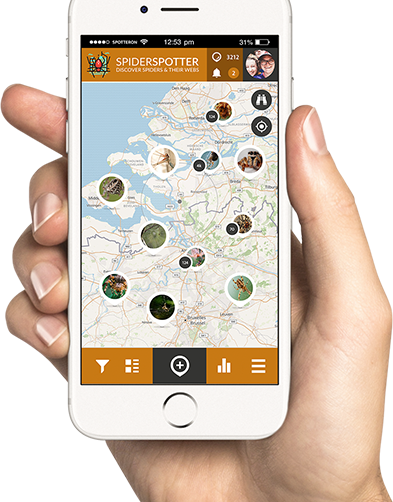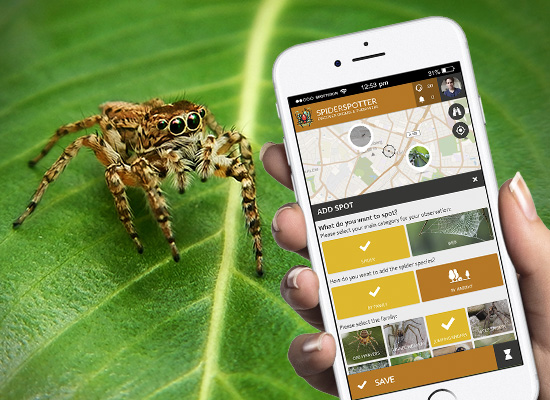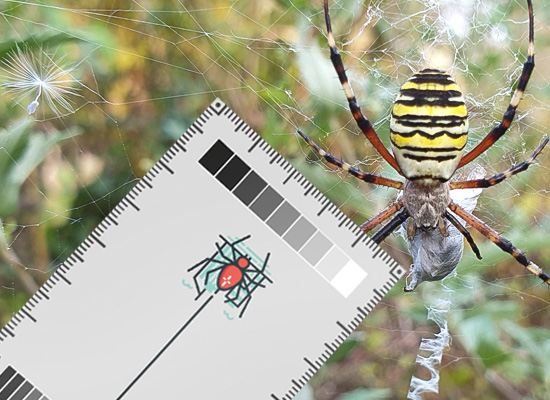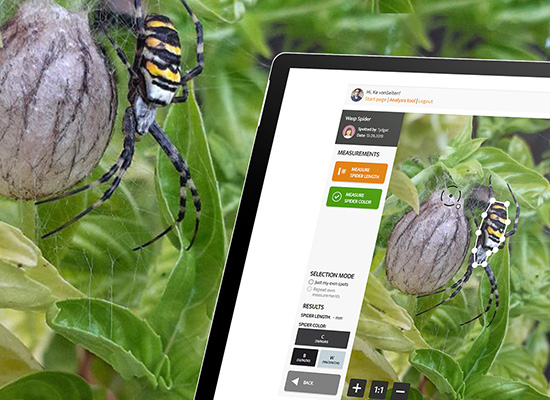
Download the SpiderSpotter App for Android or IOS and help with your observations!
Zebra jumping spider (Salticus scenicus)
Web: Jumping spiders don’t make catching webs, but use their large and well developed eyes to spot their prey from far away, sneak closer and pounce it with their short and strong legs.
Habitat: is very often found on walls and fences, sometimes in houses close to a window. Also on stones, rocks and logs.
How to recognize:
Looks similar to:
Size
♀: 5-7 mm
♂: 5-7mm
When?
♀: May till July
♂: May till June
Fleecy jumping spider (Pseudeuophrys lanigera)
Web: Jumping spiders don’t make catching webs, but use their large and well developed eyes to spot their prey from far away, sneak closer and pounce it with their short and strong legs.
Habitat: almost exclusively on buildings: on walls, roofs, fences, is frequently found inside.
How to recognize:
Looks similar to:
Size
♀: 4-6 mm
♂: 4-5 mm
When?
♀: indoor: throughout the year, outdoor: peak May till July
♂: indoor: throughout the year, outdoor: peak May till July
Hypositticus pubescens
Web: Jumping spiders don’t make catching webs, but use their large and well developed eyes to spot their prey from far away, sneak closer and pounce it with their short and powerful legs.
Habitat: often near buildings: on walls, roofs, fences, but also on rocks and logs.
How to recognize:
Looks similar to:
Size
♀: 4-6 mm
♂: 4-5 mm
When?
♀: May till August
♂: May till August
Copper sun jumper (Heliophanus cupreus)
Web: Jumping spiders don’t make catching webs, but use their large and well developed eyes to spot their prey from far away, sneak closer and pounce it using their short and powerful legs.
Habitat: on low to medium high vegetation or on the ground. Often on sunny places such as forest edges, but also in gardens.
How to recognize:
Looks similar to:
Size
♀: 4-6 mm
♂: 3,5-4mm
When?
♀: May till July
♂: May till July
Fencepost jumping spider (Marpissa muscosa)
Web: Jumping spiders don’t make catching webs, but use their large and well developed eyes to spot their prey from far away, sneak closer and pounce it with their short and strong legs. The Fencepost jumping spider sometimes catches prey that are much bigger than itself, including other spiders.
Habitat: on logs, but also on fences, gates, garden sheds and walls. Often on sunny or partially shaded places.
How to recognize:
Looks similar to:
Size
♀: 8-11 mm
♂: 6-8 mm
When?
♀: April till September
♂: April till September
Spitting spiders (Scytodidae)
Spitting spider (Scytodes thoracica)
Web: the Spitting spider doesn’t make a catching web, but stalks its prey (flies, mosquitoes) on walls and spits a mixture of sticky silk and poison in a zigzag pattern over the prey. The threadlike adhesive shrinks, pinning the prey to the surface.
Habitat: almost exclusively indoors. In summer sometimes on the outside of houses and one very strange find of a Spitting spider underneath a tussock in a field during winter (!).
How to recognize:
Looks similar to:
Size
♀: 4-6 mm
♂: 3-5 mm
When?
♀: throughout the year
♂: throughout the year
Cell spiders (Dysderidae)
Woodlouse spider (Dysdera crocata)
Web: the Woodlouse spider doesn’t make a catching web, but actively hunts its prey.
Habitat: Is found in a humid environment such as underneath stones, flower pots, bark, dead wood. In gardens and in parcs, but also in forests. Sometimes also indoors in humid cellars.
How to recognize:
Looks similar to:
Size
♀: 11-15 mm
♂: 9-10 mm
When?
♀: throughout the year, but with a peak from May till July
♂: throughout the year, but with a peak from May till July
Cellar spiders (Pisauridae)
Cellar spider (Pholcus phalangoides)
Web: an open, messy, 3D web.
Habitat: almost always in or close to buildings. Often in the corner of the ceiling in cellars or bathrooms, but also in the garage, the garden shed,…
How to recognize:
Looks similar to:
Size
♀: 8-10 mm
♂: 7-10 mm
When?
♀: throughout the year
♂: throughout the year
Nursery web spiders (Pisauridae)
Nursery web spider (Pisaura mirabilis)
Web: the Nursery web spider doesn’t make a catching web, but is an active hunter, by using fangs and legs to immobilize prey.
Habitat: often in open habitats with rather high vegetation such as roadsides, grasslands, forest edges. Also in the garden on taller grass.
How to recognize:
Looks similar to:
Size
♀: 11-15 mm
♂: 10-13 mm
When?
♀: May till August
♂: May till July
Ground wolf spider (Trochosa terricola)
Web: Wolf spiders don’t make a catching web, but are active hunters that use their legs and jaws to immobilize prey. The Ground wolf spider hunts predominantly during the night.
Habitat: underneath rocks, litter, moss, in humid areas.
How to recognize:
Looks similar to:
Size
♀: 7-14 mm
♂: 7-9 mm
When?
♀: throughout the year
♂: throughout the year

Download the App on your smartphone now or open the map in your browser:
Do you want to help measuring spiders for science? Download the SpiderSpotter Card for self printing at home and hold it in the pictures you take in the SpiderSpotter App. With the measurement reference, we can determine the size of your spider or web observation better. You can also order it at spiderspotter@UGent.be, provide your address and the number of cards you need and we will send them to you!
When holding the SpiderSpotter Card near the spider or a spider's web, please make sure that a ruler and one of the brigthness gradient strips is visible in the picture. You can read more about how to take the pics in our info section!


With the new SpiderSpotter Data Analysis Tool, you can actively participate in generating scientific data! The online interface fetches spider observations live from the Citizen Science App and offers a range of tools to measure the size and the average colour of the spiders. Simply access the Data Analysis Tool and log in with your App account!
You can even select an option to just work with your observations from the App and export your measured data if you want to do your own analysis.